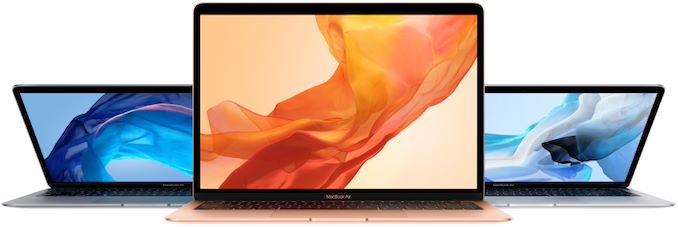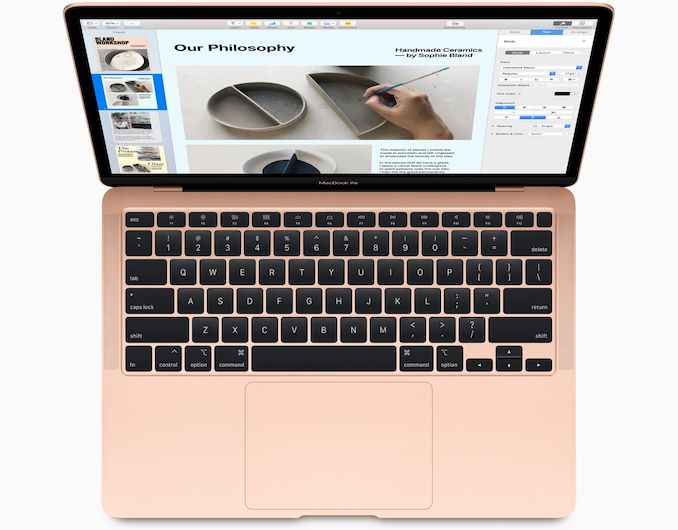Apple Reveals MacBook Air 2020: 10th Gen Intel Quad-Core and Scissor Keyboard, Starting At $999
by Anton Shilov on March 18, 2020 3:00 PM EST- Posted in
- Notebooks
- Apple
- MacBook
- MacBook Air
- Laptops

Apple has unveiled its new generation MacBook Air lineup that features a number of long-awaited upgrades, including Intel’s newest processors with up to four cores as well as Iris Plus graphics, a keyboard with scissor mechanism, more memory, as well as more storage space.
Apple’s early-2020 MacBook Air laptops come in silver, space gray, as well as gold aluminum chassis that are slightly thicker and slightly heavier when compared to enclosures used for the 2018 and 2019 machines. We are still dealing with systems that are up to 1.61 cm thick and weigh no more than 1.3 kilograms, so they are still more portable than MBAs from, say, 2017.
But the slightly different dimensions and weight also brings a big performance gain, as the new MacBook Air notebooks are based on Intel’s new 10th Generation Core processors, with up to four cores as well as Iris Plus Graphics, a significant upgrade when compared to low-voltage 8th Gen dual-core Core i5 CPUs with UHD Graphics 617 used for previous-gen MBAs.
Apple doesn't specifically mention which variants of Intel's 10th gen processors it uses, but given that they describe the graphics being Iris Plus, these parts must be based on the 10nm Ice Lake lineup, as the Comet Lake products don't feature such a GPU.
The new processors are paired with 8 GB or 16 GB of LPDDR4X-3733 memory, providing substantial performance impovements and energy savings. Meanwhile, the new systems can be equipped with a 256 GB, 512 GB, 1 TB or 2 TB PCIe SSD.
While Apple completely redesigned the guts of the new MacBook Air notebooks, it did not touch their display. The new laptops still feature a 13.3-inch IPS LCD of a 2560x1600 resolution and a 227 PPI pixel density that supports True Tone technology which automatically changes white balance depending on the surrounding environment and illumination.
Connectivity wise, the new 2020 MacBook Air are generally similar to their predecessors: they have two Thunderbolt 3 ports, a Wi-Fi 5 + Bluetooth 5 controller (a minor upgrade), Touch ID fingerprint reader powered by the Apple T2 chip, and a headset jack.
As many people have complained about Apple’s keyboards with butterfly switches, the company is now moving on back to good-old scissor switches that promise to be more reliable. To that end, the new MacBook Airs feature the company’s latest ‘scissor’ Magic Keyboard as well as the signature oversized trackpad with Force Touch.
The new MBAs are equipped with the same 49.9-Wh battery as previous-generation Airs, but now Apple rates them for a slightly lower 11 ~ 12 hours of battery life.
| MacBook Air Specifications | |||||||
| Model | 2020 (General) | 2019 (Base) | 2018 (Base) | 2017 (Base) | |||
| Dimensions | Width | 30.4 cm | 32.5 cm | ||||
| Depth | 21.2 cm | 22.7 cm | |||||
| Height | 0.41 - 1.61 cm | 0.41 - 1.56 cm | 0.30 - 1.7 cm | ||||
| Weight | 2.8 lbs (1.29 kg) | 2.75 lbs (1.25 kg) | 2.96 lbs (1.35 kg) | ||||
| CPU | Core i3-1000NG4 2C/4T 1.10 - 3.20 GHz Core i5-1030NG7 4C/8T 1.10 - 3.50 GHz Core i7-1060NG7 4C/8T 1.20 - 3.80 GHz |
1.6 GHz (3.60 GHz Turbo) Core i5 2 CPU Cores |
1.8GHz (2.90GHz Turbo) Core i5-5350U 2 CPU Cores |
||||
| GPU | Intel Iris Plus | Intel UHD Graphics 617 | Intel HD Graphics 6000 | ||||
| Display | 13.3-inch 2560x1600 IPS LCD DCI-P3 with True Tone |
13.3-inch 2560x1600 IPS LCD DCI-P3 |
13.3-inch 1440x900 TN LCD | ||||
| Memory | 8 - 16 GB LPDDR4X-3733 | 8 GB LPDDR3-2133 | 8 GB LPDDR3-1600 | ||||
| SSD | 256 GB - 2 TB | 128 GB PCIe | 128 GB PCIe | ||||
| I/O | 2x USB 3.1 Type-C w/Thunderbolt 3 3.5mm Audio Touch ID |
2x USB 3.0 Type-A 1x Thunderbolt 2 SDXC Card Reader 3.5mm Audio |
|||||
| Battery Capacity | 49.9 Wh | 50.3 Wh | 54 Wh | ||||
| Battery Life | 11 - 12 Hours | 12 Hours | 12 Hours | ||||
| Price | $999 | $1099 | $1199 | $999 | |||
When Apple introduced its 2018 MacBook Air notebooks, it increased their entry-level price to $1,199 (up from $999), which was not exactly a customer-friendly move. Last year the company dropped the price of its cheapest MBA model to $1,099, and this year it is finally back where it was several yeas ago, with the new MacBook Airs starting at only $999. Meanwhile, a quad-core Intel Core i5-based MacBook Air with 8 GB of LPDDR4X and 512 GB of storage is priced at $1,299.
Related Reading:
- Apple’s MacBook Air Gets True Tone Display, Lower Price Tag
- Apple Announces 2018 MacBook Air: Entry-Level Laptop Gets Essential Refresh
- Apple Refreshes Mac Laptops: Pro, Vanilla, & Air All Get New CPUs
Source: Apple














59 Comments
View All Comments
yeeeeman - Wednesday, March 18, 2020 - link
Seems like apple has some sort of contract with broadcomm and they still use the 3x3 wifi 5 solution, instead of adding the CRF from Intel to use the one integrated into the PCH of the Ice Lake platform.repoman27 - Thursday, March 19, 2020 - link
Apple tends to use Broadcom based modules from either Murata or USI. However, the MacBook Air has historically only been 2x2:2 for power reasons.yeeeeman - Wednesday, March 18, 2020 - link
The CPU must be throttling like crazy in this slim chassis.yeeeeman - Wednesday, March 18, 2020 - link
Anyways, if this is based on 10nm parts, it means that Intel 10nm capacity problem is gone officialy.yeeeeman - Wednesday, March 18, 2020 - link
Another thing is that these are probably the 9W range, topping out with 1060G7.KPOM - Saturday, March 21, 2020 - link
12W cTDP upgrade based on the base clock speeds.duploxxx - Thursday, March 19, 2020 - link
you think? just because there is a vendor offering these? Apple market share in laptop is very smallrepoman27 - Thursday, March 19, 2020 - link
Only 3 vendors sell more laptops than Apple (HP, Lenovo, and Dell). Apple is the fourth largest PC OEM by volume, and 80% of the PCs they sell are laptops. The MacBook Air is their least expensive laptop and generally their top-selling model. Annual volume is millions of units. The MacBook Air likely outsells any single product from any of the other vendors.So yes, this is an indication that Intel has finally managed to produce 9W quad-core CPUs on 10nm in actual volume. Or at least that Apple was able to stockpile a quarter’s worth prior to the release of Tiger Lake in a few months.
Stephen_L - Thursday, March 26, 2020 - link
On top of that apple represents 5% of intel revenue, and MacBook Air as the default Mac for Apple seems to be the most popular, Intel will only let apple to build a high volume 10nm computer when they are really confident of their process.drothgery - Thursday, March 19, 2020 - link
Not necessarily gone; nothing with more than 4 cores has been publicly released yet. But certainly this, improving availability of Ice Lake notebooks from other vendors (I got one from Dell last month), and the cancellation of Cooper Lake are signs that it's probably improving. I won't call it 'gone' until Intel has a "generation" with complete desktop, server, and mobile part lineups all shipping in volume with no 14 nm parts (and if that "generation" is mixed 7 nm/ 10 nm then I'd guess that it was never completely solved).